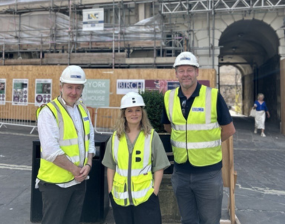
York Mansion House, the 300-year-old Georgian landmark, is set to reopen its doors this August following the successful completion of the first phase of a major £1.3 million restoration project.
To mark this milestone, ninety City of York residents will be offered the opportunity to explore the newly-restored areas through a series of exclusive, free ‘behind-the-scenes’ tours.
Organised by Buttress Architects in partnership with City of York Council, the tours will take place on Tuesday 12 August, offering a unique glimpse into the craftsmanship and conservation efforts that have gone into preserving one of York’s most iconic civic buildings. The tours follow the Georgian Festival (7-11 August) and celebrate the Mansion House’s reopening in its 300th anniversary year.
Led by Hannah Bellerby, Senior Architect at Buttress, and Richard Pollitt, Mansion House Manager and Curator, the tours will guide visitors through the building’s most significant spaces and will explain more about the repair work undertaken. Most of the restoration has focused on protecting the fabric of the building following a comprehensive inspection, as well as external repairs. The Mansion House is now even more accessible than before, and the experts will explain further what has been improved and restored behind the scenes.
The tours will start in the state room before taking in the Lord Mayor’s drawing room, the principal staircase, the dining room, the butler’s pantry, the historic kitchen, the basement vault, external passageway, courtyard, and both the rear and front elevations.
The Right Honourable The Lord Mayor of York, Cllr Martin Rowley BEM, said:
Work to build the house began in 1725 and was completed in 1732, making it one of the earliest civic buildings in England in the classical style.
"As city’s civic hub, the Mansion House holds and displays an important collection of items which tell York’s history and we’re delighted to welcome you back.”
Cllr Claire Douglas, Leader of City of York Council, said:
These tours will give residents an exclusive insight into the essential maintenance, accessibility upgrades and safety improvements to secure the Mansion House’s future as a cultural and civic asset.
"They’ll find out about how the building’s environmental performance and accessibility is now the best it’s ever been – that’s good for the environment and residents!
“Working with our architects at Buttress and building contractor Birch, we’ve solved issues that this 300 year old building has presented so that it can reopen on 6 August ahead of the Georgian Festival. Please book your tickets for these special free tours now, or please book a regular visit at a time that suits you.”
Hannah Bellerby from Buttress commented:
We’re excited to welcome local residents to see the results of our conservation works which help to ensure the longevity of the Mansion House for future generations to enjoy.
"Our focus has been on preserving the building’s historical integrity while ensuring it remains accessible and sustainable. This is a much-loved civic treasure, and its reopening - 300 years after its completion in 1725 - is a truly special moment.”
One of the most exciting discoveries during the restoration was made in the Lord Mayor’s drawing room, where seven layers of historic wallpaper were uncovered dating back to the 18th century. These layers, found on a narrow strip of wall, were then carefully removed and separated by wallpaper conservator Allyson McDermott and magnified to reveal the evolving decorative styles of the room over the centuries - providing invaluable insight for the restoration team.
A paint analysis, undertaken by Hirst Conservation, also found what appears to be a full archaeological paint record to the interior spaces of the hallway and principal staircase which allowed for an informed decision to be made on the redecoration of the spaces based on physical evidence.
Buttress Architects were appointed in October 2024 to lead the restoration, providing specialist heritage consultancy and conservation architecture. The second phase of works is expected to conclude in December 2025.


